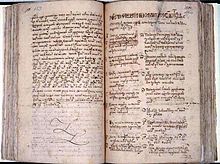Lithuanian register
The Lithuanian register is the historical archive of the state documents of the Grand Duchy of Lithuania, handed down in copy books . It is the most important historical source for the ancient Lithuanian history and therefore of great value for historians from Lithuania , Belarus , Ukraine , Poland and Russia, among others .
designation
Registries are different types of series of records-based entries (e.g. the student books of universities or civil status files of the municipalities). The German name goes back to the Latin matricula , "Stammrolle". In contrast, the Latin Graecism metrica has always been used for similar types of text in Eastern and Central Europe .
Therefore the Lithuanian register in the east is correctly called lit. Lietuvos Metrika , Polish Metryka Litewska , white. Літоўская Метрыка , uk. Литовська метрика . The plural form also occurs in each case. These terms were often translated as "Lithuanian metric", contrary to German historical and documentary usage. Historically, the name files of the Grand Duchy of Lithuania was also common, Latin Acta Magni Ducatus Lithuaniae .
description
The register includes various documents (privileges, Sejm protocols , legal acts such as court decisions, correspondence, accounting documents) that were relevant to the Grand Duchy, and all documents from Lithuanian Grand Dukes (personally identical to the Polish King since the personal union in 1386, since the Lubliner Realunion 1569 also linked as an office to the Polish royal dignity) were issued or sent to them. The register was made by the independent Lithuanian higher authority, i. H. led by the Grand Chancellor of the Grand Duchy of Lithuania. In the Crown of Poland , the Polish Crown Register, led by the Grand Crown Chancellor and Lower Crown Chancellor, was created in parallel from 1447 . The first entries in the Lithuanian register date from 1440, the last from 1795, when the Polish-Lithuanian aristocratic republic lost its independence through the third division.
Lore
The entries were made in Belorussian and Latin, and in Polish and Latin since the late 17th century. The register was transcribed between 1594 and 1607 on behalf of the Lithuanian Grand Chancellor Leon Sapieha (1557–1633, lit. name form Leonas Sapiega). In 1655 she was brought to Vilna . As early as the 18th century, eleven of them had to be rewritten because of the poor condition of the folios.
After the partitions of Poland and Lithuania, part of the matriculation was lost. The rest was deposited in Nyasvish and later in Warsaw . The books later went to Saint Petersburg and then to Moscow . The majority of the holdings in the Russian State Archive of Old Files (Российский Государственный Архив Древних Актов) are located there as Fund 389. In 1921, a part of these books was transferred to the Republic of Poland and Warsaw to the Republic of Poland due to the Riga Peace Treaty Old files (Archiwum Główne Akt Dawnych) incorporated. This inventory consists of Polish partial transcriptions of the original books and a summary of the Lithuanian registers for the years 1474 to 1751.

